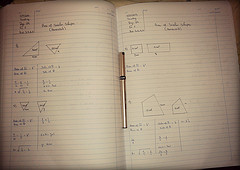See The Connection Between The Science And Mathematics Standards

Given this close connection between the science and mathematics standards based on similar words and concepts in the early grades, is this connection maintained in the higher grade levels? This article contains the content guide to the physical science and the Earth and space science standards, respectively, for grade levels 9-12. The physical science standard focuses on atomic structure and the complex geometry of molecules, and the role of shape in chemical reactions. The Earth and space science standard talks about how the heating of Earth’s surface drives the ocean currents and winds. Achieving the understanding called for in each of these science content areas would be greatly enhanced by abilities in spatial representation, visualization, and spatial reasoning. Both sets of science concepts contain critical scientific content that requires the ability to visualize structures and to keep in mind complex physical relationships that vary over space and time.
For example, understanding how the energy of the Sun drives oceanic currents and atmospheric winds is complicated. In particular, the poleward transport of energy in both the atmosphere and the ocean is modified by the rotation of Earth. Understanding the space-time dynamics requires an ability to take conceptsderived from a two-dimensional treatment of rotating frames of reference and adding the idea of the Coriolis effect to explain the more complex motion on the surface of a sphere that is required to explain phenomena such as the trade winds. The geometry standard for middle school and high school requires students to “specify locations and describe spatial relationships using coordinate geometry and other representational systems” and to engage in “visualization, spatial reasoning, and geometric modeling”. The geometry standard does not appear to be developing the associated spatial thinking concepts in a fashion that is tightly coupled to the requirements implicit in the science standards for the parallel grades.
The expectation “specify locations” is moving into formal Euclidean geometry, a logical outcome for the geometry standard. There is some development of the concepts of coordinate systems on spheres and polar coordinates, which could be drawn upon by a science teacher in the Earth science activity relating to winds and ocean currents. The understanding of coordinate systems could be used to facilitate the projection of the three-dimensional sphere into two dimensions, but the science teacherwould have to add the complicating factors of thinking about what is happening in a rotating coordinate system, something not addressed in the geometry standard.
Similarly, the “visualization” sections of the geometry standard for middle and high school students are not providing content that ties to the science standards. The standards for these grades emphasize networks and the concept of perspective. In grade levels 6-8 there is additional work on two-dimensional and three-dimensional representations. All three concepts-networks, perspective, and representation-are important domains of knowledge for students to learn and could be applied to science examples. However, in the specific case of winds and currents, only the content on representations appears relevant, and the development of an understanding of rotating frames of reference appears to be left to the science teacher.
Learning things is not limited to the scentific area. Instead it also has relations with some other things like speaking a language or using software, including Rosetta Stone Japanese and Rosetta Stone Korean. If you have a creative mind, you will make all your own differences in the end!
All of our viewers, if you want to learn more of things that are related to education and language learning, just click Rosetta Stone Swedish and Rosetta Stone Polish.
More Mathematics Articles
